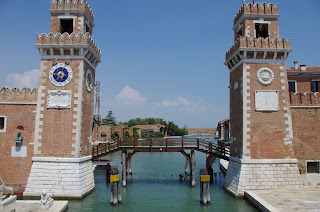More about our travels in Italy. We miss our girls, but we know they are being well cared for.
Across the Grand Canal from our hotel in the quiet and residential Dorsoduro district lies the frenetic and oftentimes chaotic hub of tourist activity, the Piazza San Marco. Here, one finds a concentration of must sees in Venice: the Doges' Palace, St. Mark's Basilica, St. Mark's Square, the Campanile rising 315 feet above the rooftops, the Venice history museums of Correr and del Risorgimento, and the list goes on.
The top three, though, are the Doges' Palace, St Mark's Basilica, and the Campanile.
We opted for a quick tour of the interior of the basilica, which was free entry. To see the Museo di San Marco and the copies of the bronze horses, the high altar, and the treasury, one must contribute five to eight euros each.
Saint Mark's Square was delightfully calm this early in the morning. The hordes from the tour busses and cruise ships hadn't quite made it all of the way here by 10am. Even the pigeons must have slept in.
We didn't hesitate to spend 8 euros for an elevator ride to the top of the Campanile, which gave us a bird's eye perspective of this marvelous city. Looking out past the Piazzetta one sees the island of San Giorgio Maggiore and its church.
Looking down it's difficult to photograph St Mark's Square in its entirety. That sure is some valuable open real estate given this densely packed island.
And looking north? towards the church of Santa Maria della Salute and the Dorsoduro district which lies between the Grand Canal and the Giudecca Canal.
And the large triangular building which was the customs house, the point of entry for all goods arriving by sea.
Looking east over the largest church in Venice, the Baslica dei Santi Giovanni e Paolo, towards the glass factories of Murano.
Leaving the throng of tourists behind, we ventured off towards the Basilica dei Santi Giovanni e Paolo, walked along the other side of the island, and stumbled onto the Arsenal. Originating in the early 12th century when they built ships for the Crusades, the newer section of the Arsenal, dating back to 15th century, the massive walls form a fortress protecting the shipbuilders.
The Arsenal has two entrances, one land the other water. The land entrance is in the form of a triumphal arch dating back to 1460 and is flanked by two lions brought from Ancient Greece.
The water entrance is marked by two towers built in 1686.
Continuing our journey, we meandered back towards the St Mark's basin and found a large avenue, which seemed strangely out of place, lined with cafes and shops. We learned that this is the only street (via) in Venice to be named such, Via Garibaldi. At the end of the street begins another canal, in which we found a floating fruit and vegetable market. The peaches, plums, and apricots looked too good to resist. They were a perfect afternoon snack in the nearby green space.
Venice is all about canals. They seem to be the calming force within the city with the gondolas softly navigating these back waterways. One can imagine how loud and frenetic the city would be if the canals were replaced with streets and gondolas with cars.
Around each corner or at the end of each alley emerges another picturesque canal scene.
Sometimes the alleys end abruptly, stairs descending into the water. Best to know your way home after an evening of drinking.
The lack of cars, mopeds, and bicycles in Venice slows time; one is forced to move at a more relaxed pace.
This city built on cypress logs is sinking, and evidence of this is everywhere. Vertical lines are not plumb and horizontals are askew on every building, and the towers are leaning, some more than others.
We noticed this tower leaning severely and searched a way to get a closer look. The bell tower belongs to St Stephen's church. According to our guidebook, the tower was struck by severe lightning in 1585 which melted the bells. It began to lean from sinking in the 17th and 18th centuries requiring reinforcement seen below in the picture.
We continued to explore the canal and alley ways of the city...
before pausing near one of the main gondola hubs next to the Hard Rock Cafe. Here, one can watch the coming and going of the gondolas, picking up fares for the 40 minute tour.
Most intriguing, though, was the craftsmanship and engineering of the gondola oarlock called a forcola. The unique shape and various notches provide different leverage points for the gondolier's oar. We discovered a shop where they carve forcole near our hotel. You can learn more by clicking this link: http://www.forcole.com/eng-home.htm
It was late afternoon and we were getting hungry.
The cruise ships, dwarfing the boats and city skyline, were heading back out to sea (reminiscent of Key West with the cruise ships leaving Mallory Pier).
It was time to find a snack before dinner: pizza, beer, and fizzy water. That should carry us over until dinner.


























No comments:
Post a Comment